Posted by James Blanchard on 03-30-2006 12:44 PM:
Yomut mafrash - eagle symbol?
Hi all,
I recently picked up this Yomut mafrash in a small shop in a
bazaar in New Delhi. I was initially drawn to its colours -- nice rose-red
field, "royal" blue, teal blue and a saturated aubergine. I was initially put
off by some red staining of the white, though on closer inspection I think that
some of that (especially highlights in some of the light elements of the kepse
guls) is actually a light rose, not a stained white.
In the end I
decided to get it partly because it still has a back and therefore retains some
appeal for me as a "utilitarian" piece (and the price was now very good for me,
about 18 months after I first saw it). In addition, on the back it has an
intriguing little embroidery in brown wool that looks to me like the Yomut
"Eagle" gul symbol. Am I imagining this? Could it be some sort of symbol of
tribal affiliation? It doesn't look particularly decorative. Have others seen
this type of embroidery on Yomut trappings?
Structure: symmetric knotting
(approx. 8h x 18v = 144 kpsi), warp looks mostly like fine, dark goat hair, with
some lighter hair mixed in.
James.

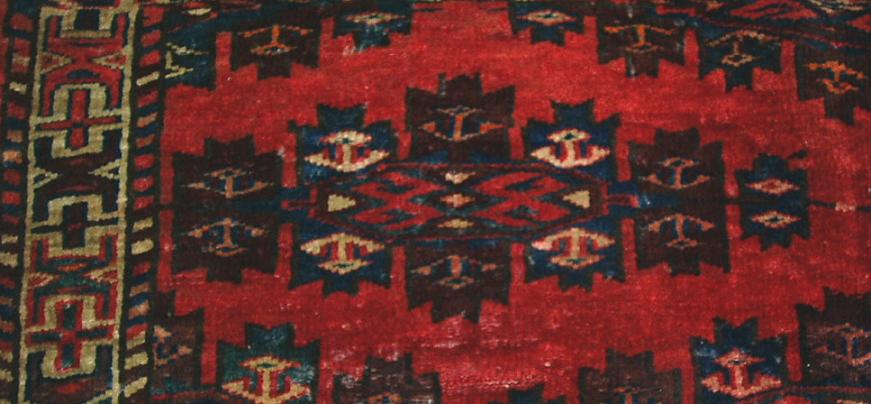
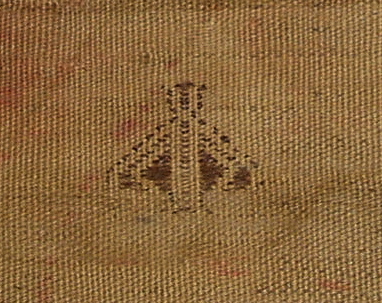

Posted by James Blanchard on 03-31-2006 03:15 AM:
One more thing...
Hi all,
Since this trapping has understandably not elicited much of a
response, I apologize for one more query about it. 
The devices at the end of the
kepse guls have two small and almost identical projections ("tear drop" shaped)
from the top corner (identified by the yellow lines). Is this just a stray
design adaptation, or is it seen more generally on kepse or other Yomut
guls?
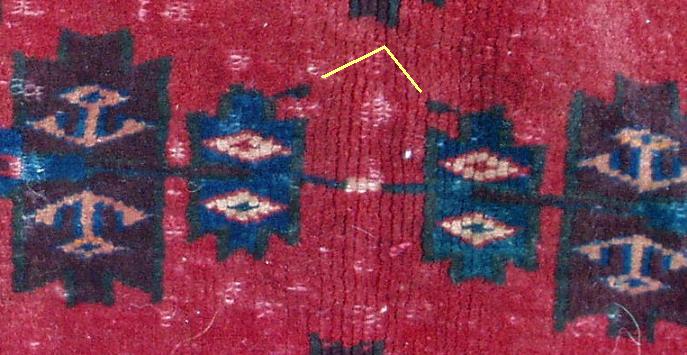
James.
Posted by R. John Howe on 03-31-2006 07:30 AM:
Hi James -
You may well sense this already but I think that what you
have is a rather late Yomut piece with some suspicious dyes in it.
The
drawing (especially of the main border) is very unsteady suggesting an
inexperienced weaver or one not fully familiar with this design. I do not think
the little extensions you have noticed in the kepse gul are a usual feature of
that device, but also not particularly significant (I just looked at a few with
a magnifying glass) but the drawing of this gul more generally on your piece
shows clear signs of conventionalization. First, the horizontal arms on a
traditional kepse gul end in a two-pronged fork device and do not touch the one
next to them. In the only area on your piece in which we can see the weaver's
tendencies in this regard (the center of the field) we see that the forks are
gone and that the ends of the arms touch. Further, the little "tower-like"
devices in which the "anchor-shaped" elements of the main gul occur have lost
some of the complexity of their crenilated tops (or bottoms depending on which
side of the gul one is examining). So this weaver has simplified and crowded the
typical kepse design in this weaving.
It may well be as you say and try
to show that there are legitimate non-color-run pinks, in this piece but I
strongly suspect the red ground and an orange I can see in the closer
image.
And there has been clear color transfer from the red into white
areas and onto the back.
I think the "eagle" design on the plainweave
back is unusual (I have seen Yomut pieces with various decorations of this sort
on their backs) but does not for me redeem the overall character of the
piece.
Just my view.
Regards,
R. John Howe
Posted by James Blanchard on 03-31-2006 08:41 AM:
Thanks for the feedback, John.
I agree that this is a rather late
piece and that there is dye-run, but now that I have had a chance to see the
piece more clearly "in the light of day", I am quite certain that those light
filler pieces are a light "apricot-pink". In fact, now that I have browsed
around a bit I see that it is very common for this alternating of white and pink
or light orange in those elements.
Not that I feel the rug needs or
deserves any defence, but the red is better than it looks in the photos, but I
suspect it to be either "chemical", or a "runny natural". But I am no expert in
this.
As I mentioned in my first post, I too have had considerable
reservations about this piece, but it grew on me. The weaver was no master, as
you have mentioned. In addition to the borders, one can see how she had trouble
sorting out how to balance the "hiding" guls at the top and bottom. The top ones
are different from the bottom. So altogether a bit quirky and
"amateurish".
Having looked at a few more eagle devices on other Yomut
weavings, I am quite convinced that this is meant to represent that. Maybe it
was just a weaver's doodle.
James.
Posted by Chuck Wagner on 03-31-2006 06:10 PM:
Hi James,
I don't think there's really any doubt that your doodle is
an "eagle" motif. Here's one from the back of a Yomut mafrash that we own. Now,
this is a doodle (or two of the smallest eagles you'll ever
see..):
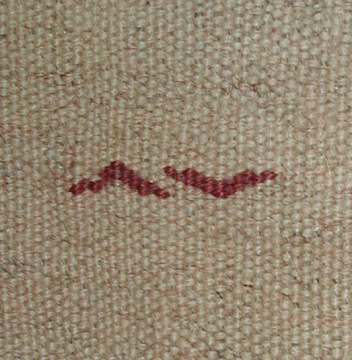
Regards,
Chuck
__________________
Chuck
Wagner
Posted by James Blanchard on 03-31-2006 10:57 PM:
Hi Chuck,
I think yours are the universal symbol of "flying birds" in
simple grade school drawings. Eagles? Vultures? Seagulls?
Here is another
example of a "doodle" on the back of a flatwoven bag from Jamal Barez (Kerman
Province).
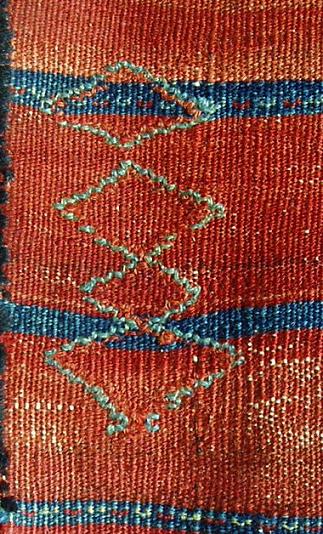
This does not seem to be any recognizable design motif. Maybe
just a "name tag"? If others know what these crude embroideries represent, I am
curious to find out.
James.
Posted by James Blanchard on 04-01-2006 04:04 AM:
Tamga?
Hi all,
I just read an interesting article by Richard Wright on the
"tamga" (ref: http://www.richardewright.com/0905_tamga.html). Referencing a
1918 publication by M.A. Czaplicka, he states:
quote:
In this particular folk art, one possible ingredient could well be the tamga:
"...the symbol of a subclan...a group of families affiliated by blood...whose
livestock, whether reindeer, horses, or dromedaries, are marked by this
symbol. The tamga also appears on various belongings, as well as on the graves
of deceased members of the clan."
Later in the article it is mentioned that these "family brands"
were used on a variety of family items, including weavings. None of the symbols
illustrated in the article are the same as the "eagle" on my mafrash, but I
wonder if the concept is relevant.
James.
Posted by R. John Howe on 04-01-2006 07:06 AM:
James -
The notion of "family brands" that I like best (although it
has grisly overtones and its truth is uncertain) is that of the Irish "Aran"
Sweaters.
http://en.wikipedia.org/wiki/Aran_Sweater
http://www.irishcultureandcustoms.com/AEmblem/Sweaters.html
As
you can see, some say that not only did the Aran fisherman wear such sweaters as
they fished, but that each family had a design. It was (again said to be)
calculated that wool would last longer than a recognizable body of a drowned
fisherman, giving an alterative mode of
identification.
Regards,
R. John Howe
Posted by Chuck Wagner on 04-01-2006 09:13 AM:
Hi James,
Here's a couple more examples. The first is from the back of
a Baluchi saddle bag from the Sistan region; it's reminiscent of your
tamga-esque feature:
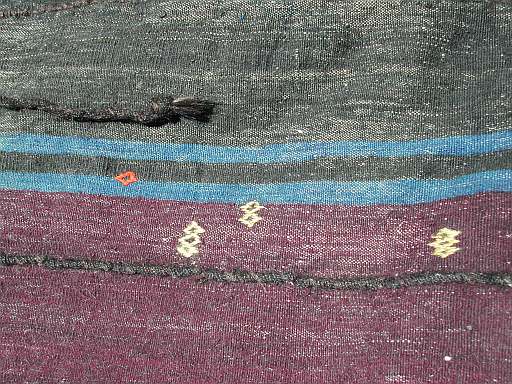
The next is from the back of a Hazara saddle bag, and to me,
appears to be a "watchful eye" device"

Regards,
Chuck
__________________
Chuck
Wagner
Posted by James Blanchard on 04-01-2006 10:36 AM:
John -
Those look like well-made sweaters. We don't use many of those
in India, but they come in handy in Canada in January. I think there is some
difference between an overall pattern that is emblematic of a family or clan and
the post-hoc addition of a small and crude notation that is perhaps more like a
"name tag".
Chuck -
I am interested in the additional examples
you've shown. I wonder if there has ever been any systematic study of these
symbols. Perhaps the subject is too arcane to pursue now.
James.
Posted by R. John Howe on 04-01-2006 10:51 AM:
Hi James -
My Aran sweater reference is a true aside, but you liken
Aran family designs to a "small, crude, name tag" like notation.
Please
note that that is not the claim:
"...Even a trusted authority, Anthony
Bluett, writes in his book 'Things Irish” that ...”a particular design could
identify a given family, just as tartans were used for the various clans of
Scotland.'..."
One would need to be careful to denigrate a design feature
that flows at the level of the Scottish tartans (even if most of that system was
elaborated, I read somewhere, by an English lowlander).
I have not head
that the Aran folks express themselves with any particular violence but they are
Irish. 
Regards,
R. John Howe
Posted by James Blanchard on 04-01-2006 11:14 AM:
Hi John -
Sorry if I was unclear, but I meant the opposite. I
understood the Aran sweaters to be "an overall pattern that is emblematic of a
family or clan" and the notations on the backs of the Asian weavings to be "the
post-hoc addition of a small and crude notation that is perhaps more like a name
tag". I certainly don't want anyone's clan getting cross with me!
James.
Posted by Wendel Swan on 04-01-2006 01:17 PM:
Dear all,
I don’t know whether the various references to the “eagle”
motifs and doodles reflect a belief that eagles are actually represented or
whether it’s being used as a mere label. But I don’t believe for an instant that
there are any eagles to be seen here.
Floral motifs of various sorts are
commonly seen in Turkmen weavings, including on the elems of both main carpets
and chuvals. I submit that here we are seeing yet more instances.
First
compare this “eagle” elem motif (which I have elongated somewhat) with various
“egg palmettes” (so described, I imagine, because of their ovoid shape)
discussed and compared long ago in the salon on the Italian Carpet.

Now compare the
cross section of a flower and its components with the “eagle” and with the
Italian Carpet’s palmette. Aren’t we seeing the same thing?

In the case of the
Yomud “eagle” elem motif, the top of the leaves of the blossom turn inward, not
outward, but the various components of the flower are recurrent
features.
The bud and stem is seen in weavings across the breadth of
Islamic. Flowers and floral motifs, along with purely geometric forms, dominate
Islamic art.
The brocading on the back of the bag looks like yet another
variation of the ubiquitous bud and stem.
It’s hard to say what the
doodles are or may have been, but I like the term doodles a lot; it doesn’t
purport to interpret what we see as representational. And I think it’s
impossible to guess what these doodles may ever have represented, if
anything.
A few years ago, Turkotek readers were subject to the most
preposterous hypothesis of raptors’ wings in all manner of Turkmen weaving and
their connection, inexplicably, to North American natives.
The great
problem with using catchwords such as “eagle” for motifs is that the term will
be taken literally as representational of that term. And some of the literature
does refer to this motif as the outline of a bird in flight. Yes, a flight of
fantasy.
Wendel
Posted by Tim Adam on 04-01-2006 02:54 PM:
Hi Wendel,
So, if what you say is right, then we have been looking at
the "Eagle" device upside down.  Interesting observation.
Interesting observation.
In my experience many of the designs
on rugs seem florally motivated. So, I am not surprised that the "Eagle" may be
jet another floral motive. However, the "Eagle" also has the lower part to it
that looks like a head with two antennas sticking out. If this is a common
characteristic of the "Eagle" device, then I think one could not rule out the
possibility that it represents an insect, such as a butterfly.
Tim
Posted by Tim Adam on 04-01-2006 03:07 PM:
Hi James,
"I wonder if there has ever been any systematic study of
these symbols. Perhaps the subject is too arcane to pursue now."
I
bet there is nothing on this topic, but I think it is an interesting question.
In my mind there is certainly some meaning behind these doodles. A first step
would be to catalog the various devices.
Tim
Posted by Chuck Wagner on 04-01-2006 05:34 PM:
Hi Wendel, et all,
I don't really have an opinion on the "eagle"
issue, and your points about floral geometry are not unreasonable.
One
can, however, understand how the term may have come to be applied to this motif
by observing the following image of a Red Tailed hawk that was kind enough to
park atop a No Parking sign and strike a pose, thusly:
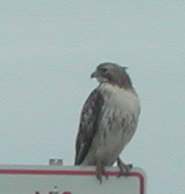
A rug dealer in search of a
tale could certainly point to one side or the other of the motif in question and
state convinvcingly: It is an eagle, dear buyer..
regards,
Chuck
__________________
Chuck
Wagner
Posted by James Blanchard on 04-01-2006 09:31 PM:
Hi all,
I am not sure whether these are eagles or flowers. I was only
using a term for the motif that seems "conventional" in the rug literature with
which I am familiar.
If it is a flower, then the Yomuts appear to use it
upside down a lot. One can see the simplified versions of this device on many of
their ensis. Here is an example from Barry O'Connell's "Oriental Rug Notes" site
- www.spongobongo.com/her9971.htm.


If the back of my
mafrash was sewn closed, then the doodle on the back would be oriented in the
same direction as we see on the ensi. I suppose that if originally derived from
Persian floral designs, then it could have lost its meaning and orientation over
time.
According to Richard Wright's article on "The Tamga" http://www.richardewright.com/0905_tamga.html many of the
Turkmen clans had a "totemic" bird that was "almost always a raptor".
Interestingly, the "brand" raptor tamgas illustrated are very simple and none
look very much like this Yomut "eagle" device.
Although I expect that
collecting examples of these "doodles" might not lead anywhere of significance,
I like Tim's idea of "cataloging" them. If others are interested, perhaps they
could dig through their collections and show examples.
James
Posted by Chuck Wagner on 04-01-2006 09:41 PM:
Fingerquake
Hi James,
We can be a little better aligned with the academic rug
world if we refer to pieces such as yours as a torba rather than a mafrash. I
caught my own fingers slipping in my previous post. Oops.
Mafrash is a
term used to describe the box shaped carrying sacks that the Persian nomads
strap to the sides of their camels and horses (only the really big
horses). They're most often done in flatweave, although a few have areas of pile
and very few are all pile. Torbas are much smaller bags that are hung
inside yurts and occasionally on pack animals.
Regards,
Chuck
__________________
Chuck
Wagner
Posted by James Blanchard on 04-01-2006 11:50 PM:
Hi Chuck.
I am a novice, so open to correction on this.
In
classifying various types of Turkoman weavings Ian Bennett defines a mafrash as:
"A narrow bag usually measuring 2-3 feet in width by about one foot in depth."
He defines a torba as: "A bag about the same width as the juval but half the
depth; in other words, a slightly larger version of the mafrash."
Is that
classification mistaken or out of date?
James.
Posted by Steve Price on 04-02-2006 07:24 AM:
Hi James
Bennett's use of the terms is the one generally accepted in
Rugdom, and is probably the one used by the Turkmen as well.
The word
"mafrash", confusingly, has two different meanings. One is the box-shaped cargo
bags made mostly in NW Iran and the Caucasus. The other is the small bag made by
Turkmen. If you gave the dimensions of yours, my quick scan of the thread didn't
see it. It might be a torba, might be a mafrash, might be in the size range that
is ambiguous between those two.
An aside on the "eagle" device: One
problem with trying to make representational interpretations of such things is
that it almost never involves much more than guesswork, and the number of
possible guessses that are more or less equally plausible is unlimited.
Bear in mind, too, that lots of things that were familiar to 19th
century natives of central Asia are so unfamiliar to us that we wouldn't even
include them in our guessing.
Another confounding factor is that motifs
have been modified and stylized over time. This is just as true for western
symbolism as it is in Turkmen and other more exotic cultures. A stranger from
another planet, finding a Christian cemetery with rows of white crosses, would
never guess that they are stylized symbols of the crucification of a
man.
Regards
Steve Price
Posted by James Blanchard on 04-02-2006 09:54 AM:
Thanks Steve.
The pile part of the bag measures 38" long by 17" high.
Torba or mafrash?
James.
Posted by Steve Price on 04-02-2006 10:06 AM:
Hi James
Torba.
Regards
Steve Price
Posted by Tim Adam on 04-02-2006 12:55 PM:
Hi Steve,
You wrote, "One problem with trying to make representational
interpretations of such things is that it almost never involves much more than
guesswork, and the number of possible guessses that are more or less equally
plausible is unlimited."
I think this is a bit too strong. Educated
guesses on design origin or interpretation are interesting in my opinion. Even
if no theory can be proven, and we are always stuck with guesses, a lot of
theories can be ruled out. And even if we are still left with infinite plausible
theories, there is still value, because these theories will share common
elements. To illustrate, the set of prime numbers is infinte. Nevertheless it
useful to destinguish it from the set of all numbers.
Tim
Posted by Chuck Wagner on 04-02-2006 01:36 PM:
Hi James,
A review of some available literature could add quite a bit
to any confusion you already have regarding terminology. I am not an student,
but rather, an observer of Turkmen folk art. It is possible that within the
academic community there is now some common set of criteria with which one
classifies certain articles.
My personal experience is one of mixed
messages. When we were overseas, the Afghan and Persian dealers we dealt with
always referred to all small rectangular Turkmen bags as torbas (recognize that
small rectangular pieces with no back (and therefore, not bags) were
produced and used as door skirts; these are called "germesh").
For an
example in print, see: Jourdan, in Oriental Rugs Vol. 5,"Turkoman", a relatively
clear definition in the text is followed by dozens of mixed messages in the
captions. There are too many to be mere typographical errors, and one must
wonder if Jourdan (who may have had his hands on more Turkoman pieces than
anyone else in modern history) used criteria other than simple dimensions to
make his determination.
Other publications show similar discrepancies. A
publication of the Turkmen SSR State Fine Arts Museum entitled "Turkmen Folk
Art" (Medzhitova, Dzhumaniyazova, Grishin, 1990) also refers to very small
articles (that Bennett would call mafrashes) as torbas.
I didn't mean to
add to your confusion, and should have brought up the size issue when I made my
comment.
Regards,
Chuck
__________________
Chuck
Wagner
Posted by Steve Price on 04-02-2006 01:41 PM:
Hi Tim
Speculating on what a motif or design represents is interesting
- I agree. The issue isn't proof, which is probably out of the question. But
evidence that one (or a few) alternatives are much better than the others would
be helpful. The fact that some interpretations can be completely eliminated
doesn't impress me. I don't need to see any motifs to know that pre-World War II
Turkmen had no motifs that represent a computer or a grand piano, and I'm not
sure you can eliminate many things less trivial than those.
Let's, just
for fun, look at some of the more obvious possibilities for this set of related,
but not identical, motifs. All are in a row on the same piece, which we can take
to suggest that the meaning of all is the same (if the weaver, in fact, had a
meaning in mind).

We've already had suggestions. These include,
1. Bird of prey
2.
Floral elements
3. Insect
Let me add a few to the list.
4. Man
with small head flexing biceps
5. Man with large head flexing pectoral
muscles
6. Wheel barrow
7. Woman giving birth
8. Man with prominent
penis
9. Floor plan of walled garden with a house at one end
10.
Confronting heads of animals or snakes
11. Tent
12. Tree
We could
extend the list in many directions if we use the assumptions that some people
adopt. Sue Zimmerman, for example, thinks "authentic" weavings are calendars and
would accept this motif or textile as "authentic" only if the numbers add up (if
I'm recalling her words correctly, and I think this is at least approximately
right). Others would tell us to look only at the negative space for meaning,
virtually eliminating the entire list above.
I don't find these
considerations very illuminating.
Regards
Steve Price
Posted by Tim Adam on 04-02-2006 02:31 PM:
Hi Steve,
I agree, these considerations are not very illuminating, but
to me 4-12 are uneducated guesses, guesses without reasonable
basis.
Tim
Posted by Steve Price on 04-02-2006 03:03 PM:
Hi Tim
Number 6 (wheelbarrow) is clearly without basis and facetious.
But none of the others are, and all have foundations as firm (or as weak) as the
first three. Here, briefly, is what they are.
4. Man with small head
flexing biceps. I don't know of any unambiguous textile motif of this, but
muscular men are depicted in many poses in sculptures and reliefs in ancient
cultures.
5. Man with large head flexing pectoral muscles. Same comments as
for number 4.
6. Wheel barrow. Ridiculous (facetious), and not to be taken
any more seriously than supposing the motif to be a bicyclist coming straight at
you.
7. Woman giving birth. An ancient symbol that had special importance in
central Anatolia during the bronze age and earlier. The so-called "ellibelinde"
motif on old kilims is believed by many to be derived from it.
8. Man with
prominent penis. This an unambiguous motif in some Persian tribal weavings and,
if my memory is working today, in textiles from southeast Asia and the Caucasus.
You can see some examples in Fred Mushkat's salon on bands.
9. Floor plan of
walled garden with a house at one end. The general notion of a garden plan is
commonly invoked for Persian "garden carpets" and a variant on it (a cosmic map)
is included in the interpretations given by the locals for one of the major
groups of Kaitag embroideries.
10. Confronting heads of animals or snakes.
This theory of the so-called "animal tree" motif was championed by James Opie
and enjoys fairly wide acceptance in Rugdom (I am not one of its adherents, if
that makes any difference).
11. Tent. I don't know of any specific motif
generally interpreted as a tent, but it doesn't take an awful lot of imagination
to see the possibility that this could be one. Note that Turkmen "yurts" have a
vertical sidewall about four feet high, with the "dome" atop it and a smoke-hole
right in the center. Surely, the yurt was as significant to Turkmen as any
element in their environment.
12. Tree. Representations of trees, shrubs or
plants are common and unambiguous in many textiles from central and western
Asia.
To make a long story short, every one of these (except the
wheelbarrow) has at least as much going for it as the bird of prey and is miles
ahead of the insect if this is a race toward plausibility. I don't think the
fact that a motif brings a particular thing to my mind or yours is very good
evidence that this was the weaver's intention.
I don't suggest that the
exercise isn't fun, only that it doesn't lead to knowledge all by
itself.
Regards
Steve Price
Posted by Tim Adam on 04-02-2006 03:54 PM:
Steve,
You are making big steps here by making references to
non-weaving cultures and those that are thousands of years away. Some time ago
somebody on this board (I think) made a connection between native American art
and oriental designs. That's similarly meaningless. Your other references to
Persian weavings or quite clearly defined symbols, such as the 'animal tree' are
not convincing either.
It's a bit tedious to go through your list point
by point, so let me say why I find the other design interpretations plausible
hypotheses.
1. Bird: Quite close to the real thing. Birds have been
depicted in other Turkmen weavings.
2. Cross-section of flower:
Reasonable closeness. Depictions of flowers in various forms are all over the
place. However, the fact that the flower is usually found upside down, puts some
serious doubt on this hypothesis.
3. Butterfly: Also a flying object, and
in an abstract representation may not be destinguishable from a bird. Has a
positive image across different cultures, so its depiction on a rug is not
absurd. The one thing that speaks for it is that it would explain the meaning of
the antennas.
Tim
Posted by David R.E. Hunt on 04-02-2006 08:08 PM:
Alternative Theories...
Hi Tim, Steve, All
Louis Dubreuil, in his Hash Gul
Story thread here on Turkotek, posited an interesting theory regarding the
origin and "evolution" of the Yomud "eagle" motive, which suggests an origin
more at geometric than representative.
Dave
Posted by Steve Price on 04-02-2006 08:08 PM:
Hi Tim
Just a few points.
1. The ellibelinde is still a common
motif, especially on Turkish kilims. It isn't an ancient symbol that has long
been lost. There's been ample opportunity for it to find its way into the
Turkmen vocabulary and undergo Turkmenization.
2. Images from non-textile
sources are commonly the stuff of which art historical approaches to motif
vocabularies are made.
3. The "animal tree" is common on Turkmen ensis,
although Jim Opie believes it originated in bronze age Luristan.
4. The
argument that the references to Persian motifs from rugs and animal bands isn't
convincing seems like an ad hoc elimination of those sources. They aren't
convincing to me either, but they are no less convincing to me than the bird or
insect, and not grossly less convincing than the floral interpretation.
For the record, I don't think any of those has a strong enough basis for
me to argue that they're correct. But I think the same is true for the other
interpretations.
The argument based on saying that the motif in question
here really looks quite close to a real bird (your position) is not very
persuasive to me. It has some bird-like characteristics, but I wouldn't describe
it as being quite close to a real bird.
Perhaps we should simply agree
to disagree. That would work for me.
Regards
Steve Price
Posted by James Blanchard on 04-03-2006 01:05 AM:
Hi all,
It occurs to me that there is a difference between what we
call a design motif, and what it might have meant to the weaver or weaving
group. As Steve points out, it often isn't easy to definitively identify what a
given design depicts, or what is its design lineage. But we still need to call
it something today to facilitate communication. It seems that many will
understand a reference to the design motif in question as the "Yomut eagle",
regardless of what it is actually meant to depict.
Cheers,
James
Posted by louis_dubreuil on 04-03-2006 05:04 AM:
design ambiguity
Bonjour à tous
Yomut productions are known, more than other turkmens,
for using designs that are ambiguous. They make flowers that look like animals
and animals that look like flowers. This is the main caracteristic of the yomut
style. I think that is because this central asia group is historicaly on the
crossing of persian and eastern (mughal) influences.
I think we can
interpretate without a great risk those ambiguous designs as original animal
forms modified by floral style : it appears that all the design vocabulary of
the ancient peoples living in central asia (peoples of the steppes) is of animal
origin (see all the stuff found in the Paziryk kourganes and the work made by
Opie about the Luristan art).
The peoples of the steppes lived with
animals (sheep, goats, camels), hunted with birds of prays (they continue to do
that nowdays). All their subistences came from animals. They did not cultivate
plants, they did not make gardens.
The use of animal for ornementation of
usual or prestige objects in the culture of the peoples of the steppes is to be
related to the ancient chamanic religions that predate the islamisation of those
peoples. The chamanic religion is originated from hunter-gatherer peoples and is
a believing based on the possible connexion with the spirits of animals used as
intercessors between the terrestrial world and the OTHER WORLD (earth, sky, sea
and the creatures that live in).
In this context it is well known that birds
play a great role in connecting the world of the dead souls to the world of
living men.
The derivation of the animal design (including birds) in a more
floral style can be related to the islamisation, islam forbiding the
representation of animal forms.
Bonne journée à tous
Posted by Steve Price on 04-03-2006 05:18 AM:
quote:
Originally posted by James Blanchard
Hi all,
It occurs to
me that there is a difference between what we call a design motif, and what it
might have meant to the weaver or weaving group. As Steve points out, it often
isn't easy to definitively identify what a given design depicts, or what is
its design lineage. But we still need to call it something today to facilitate
communication. It seems that many will understand a reference to the design
motif in question as the "Yomut eagle", regardless of what it is actually
meant to depict.
Cheers,
James
Hi James
I am in complete agreement with everything
you just said.
Regards
Steve Price
Posted by louis_dubreuil on 04-03-2006 09:33 AM:
Hali article
Hi James
in order to illustrate this discussion, turkotekers can refer
to the Tom Cole's article in the last Hali issue (#145, pages 57, 58). In this
article Mr Cole speaks about the relations between Bronze age artifacts and
architecture, and the designs that can be found in turkoman weavings.
Mr
Cole quotes Viktor Sarianidi, a russian archeologist who has studied the antique
city of Gonur Tepe in the ancient delta of the Murghab river (southeastern
Turkestan).
The parallel is made between bronze seals with animal motifs
(eagles, scorpions, spiders...) and the motifs that can be found in turkmen
items (amulets, clothes, weavings...).
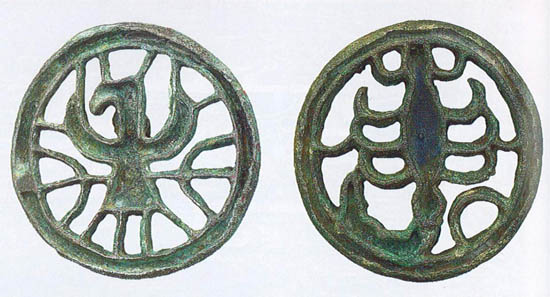
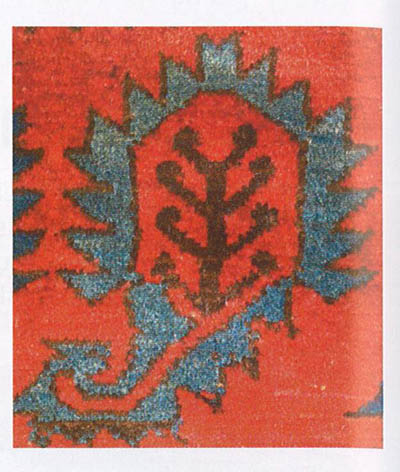
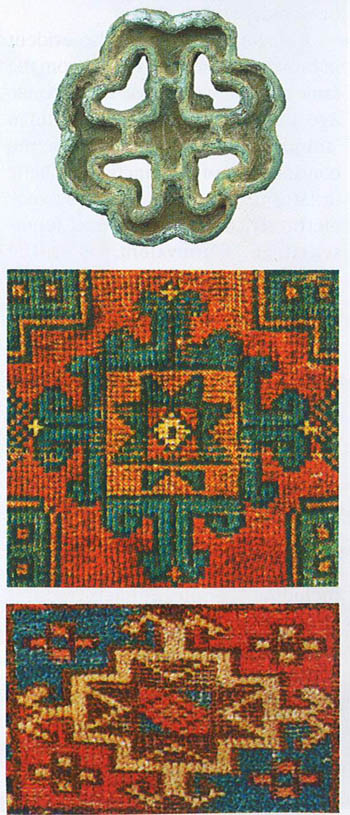
V. Sarianidi "speculates"
about the talismanic function of thoses motifs.
In this article there is also
a wonderful aerial picture of the Gonur site with the main temple's plan drawn
like a gul.

Bonne journée à tous
Posted by Patrick Weiler on 04-04-2006 12:05 AM:
Tamgas or not? Extraneous motifs on weavings
I have an old Shahsavan piece with a bit of embroidery on part of it that has
nothing to do with the design. It also does not appear to have any specific
meaning, such as a date or signature. In another thread, there is speculation
that these random embroidered motifs may be tamga's. Perhaps we can move these
examples to a thread devoted to them.
Here is my example:
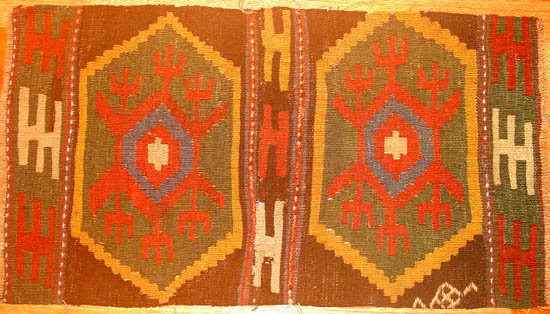
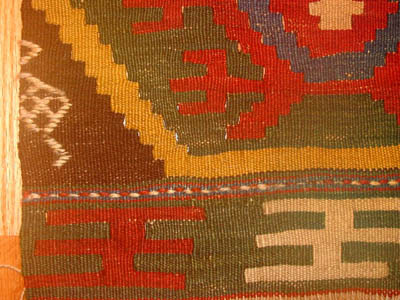
The color reproduction of the
piece is nothing less than horrible, but the embroidery is quite easily seen.
The piece consists of two panels from a larger weaving. It is likely that the
embroidery continued in some form onto another, missing, part of the weaving.
Enough is seen here to foster speculation as to what the original design may
have meant. There is no way to tell which direction is up, but the lower photo
shows the design either upside down or right side up. The panels may have been
either end panels from a mafrash or front panels of a khorjin.
I will post a
couple more examples soon, and maybe I can get a more realistic color
reproduction of this piece, too.
Perhaps with enough examples, a trend may
appear.
Patrick Weiler
Posted by David R.E. Hunt on 04-04-2006 11:47 PM:
Parallel Evolution
Hi Patrick
The Richard E. Wright piece regarding The Tagma
raises a question which, in a larger sense illustrates
some of the problems
inherent in sorting out the origins of customs, symbols, etc. among people who
live such similar lifestyles. Wright states
That tamgas owe a debt to the
Arab alphabet as a result of the 7th/8th century Arab incursion into Central
Asia seems to require evidence, not offered. The contention ignores matters such
as the then whereabouts of the Oghuz (east of the Arab sphere), the rather
prompt ebbing of the Arab tide, the correspondence of some Timurid (16th c.)
fabric patterns with some motifs used in Turkmen carpet design, and the 8th
century Koshno-Tsaidan and Orkhon Turkic inscriptions, the first Turkic writing.
In Joy May Hilden's The Use
Of Wasm in Beduin Weaving, we same similar markings discribed as being used
to identify both livestock objects, much as the Tagma.
Dave
Posted by James Blanchard on 04-05-2006 01:47 AM:
Hi David,
Many thanks for the Hilden reference. It strikes me that
this is part of a kindred practice. Hilden surmises that these wasm could be
helpful in identifying the tribe and location of Bedouin weavings. I wonder if
this could also be considered for other weaving groups.
James.
Posted by Patrick Weiler on 04-06-2006 01:33 AM:
More Tamga's?
Here are some better pictures of the first weaving.
The color is much
closer to the real thing:

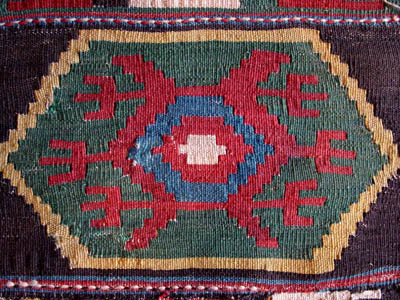
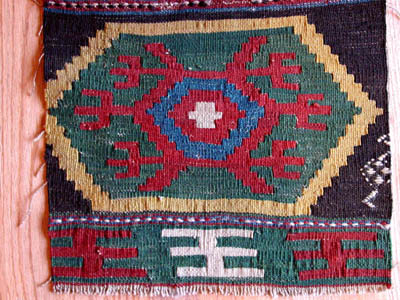
I have still no clue if there is
real meaning to these random extra weft designs. The overall design is quite
similar to other Shahsavan weavings, but this one is so far unique in that the
central rays from the medallion are three-forked like the other rays. No other
weavings I have seen with this design have all three rays forked. Most of them
also have sumak outlining of the designs, but this one is only slit weave
tapestry construction.
Here is a spoon bag. The inner border has a design
strikingly similar to the design in question on the piece James Blanchard posted
on the Eagle Gul thread elsewhere on Show and Tell. His is a Yomud piece and
this is SW Persian, Bakhtiari or Luri, but in David Hunt's link to the Richard
Wright article, it says:
"it might be useful to look more than casually at
Yomud wedding camel trappings, door surrounds, interior storage items such as
spoon or spindle bags"...and here is a spoon bag with a marking quite similar to
some of those shown in the Wright article.
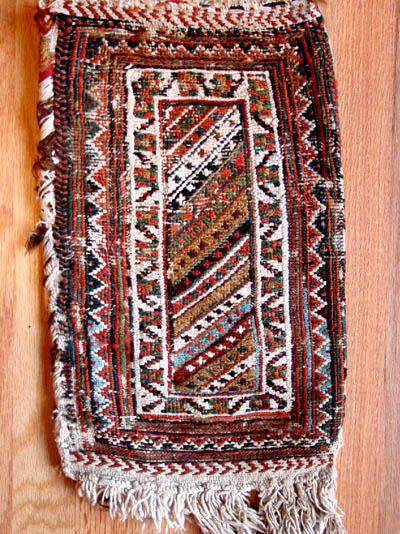
The back has several cross-shaped
devices in extra weft patterning:
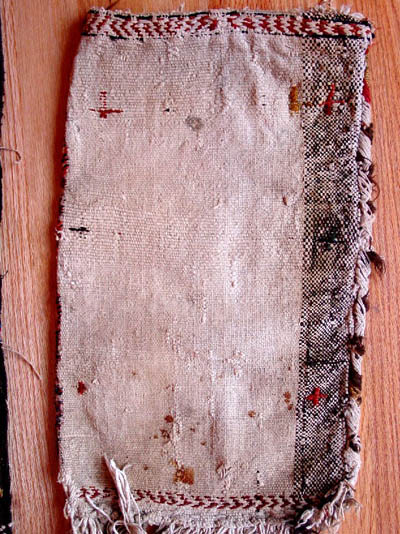
Random or meaningful?
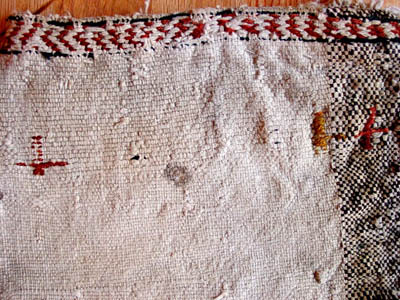
This is a Baluch balisht. Notice the
goat-hair closures at the top. The no-longer extant back would have had the
other half of the closure system attached to it. The goat hair is "closed", or
attached on the front of the bag, but on the back, there are loops. This may be
an indication that the closure system would have been "hidden" from the surface,
thereby allowing this weaving to be used as a pillow rather than a more typical
storage bag with the closures on the outside.
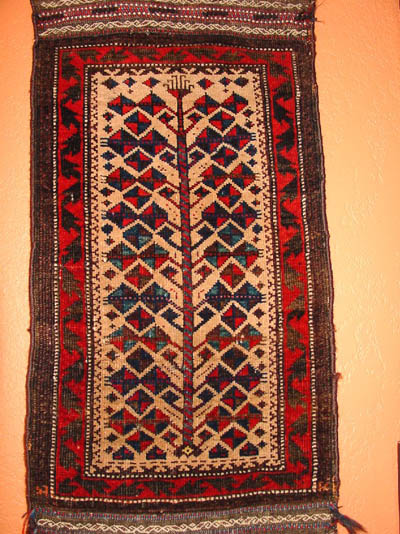
The lower corners have one unit of a
repeat which is in a much darker color the rest of the way around the border. I
believe it is of the same design as that along the inner field, a sort of
miniature tree or bush. But the highlighted small design at each lower corner is
rather mysterious. A tribal tamga, perhaps?

Are there more examples of this type
of odd added elements on weavings you own or know of?
Patrick Weiler
Posted by James Blanchard on 04-06-2006 02:32 AM:
Another "amateur" kepse gul torba...
Hi all,
As John pointed out, the weaver of my torba struggled with the
design and proportions for the weaving. It reminds me of another Yomud kepse gul
torba that Steve Price wrote about...http://www.rugreview.com/145mist.htm
Here is the
picture. 
In
addition to the obvious struggles with scale of drawing, the drawing of the
kepse gul is, well, "unconventional". She too ran out of room for the "c" forms
at the end of the guls, and sometimes doesn't even try to put a crenalated
"crown" at the tops of the devices.
Do we see more of these poorly
executed examples in utilitarian pieces?
Louis, thank you for the
reference to Tom Cole's article. It looks interesting.
James.
Posted by Unregistered on 04-07-2006 09:22 PM:
Tamga/Damga and IMler in Kilims
Dear Patrick,
In Anatolian kilims damgas (also called 'Im in cental
Anatolia) are ubiquitous. Depending on where you are, they are fertility
symbols, apotropaic (evil eye protection) symbols, tribal identifications etc.
They vary according to regions, but they serve the same function.
There
is a chapter in a book in Turkish by Yusuf Durul ("Yoruk Kilimleri") published
by Ak Yayinlari in Istanbul in 1977, that discusses the 'Im used by Yoruk groups
in the Nigde-Bor triangle. The author interviewed women in that region to
determine what meant what. Stylized oak leaves, poplar leaves, and other
vegetation were meant to bring long life. Ram's heads and ram's horns were signs
of strength and manliness. He also illustrates emblematic 'Im of the Kinik
yoruk, Yesilyurt yoruk, Bayat yoruk, Sarikecili yoruk and Kayi yoruk in that
specific region of Anatolia.
If you are interested, I can scan some
damga/'im from a page.
Best regards,
Ken Thompson
(This
shows me as unregistered, but I could not retrieve or reset my password and the
system would not send the info to my email. So unregistered I remain.)
Posted by Filiberto Boncompagni on 04-08-2006 02:24 AM:
Hi Ken,
I used the software option “Email password reminder user” and you
should receive your password - twice, actually, my mistake  .
.
If that doesn’t work, let us
know.
Regards,
Filiberto
Posted by Steve Price on 04-08-2006 07:36 AM:
Hi Ken
You are registered as Kenneth Thompson, so if you signed in as,
say, Ken Thompson, it will not recognize you.
Regards
Steve
Price
Posted by Kenneth Thompson on 04-08-2006 05:04 PM:
Dear Steve and Filiberto,
Many thanks for your help in getting
re-established. I should have grabbed an anti-evil eye damga before trying to
log on originally. 
Best regards,
Ken Thompson
Posted by R. John Howe on 04-09-2006 06:24 AM:
Hi Ken -
Good to see your voice again.
It sounds like your
books bear out some of the indications made by the "committee" in the set of
books on Turkish pile rugs that I identified in another thread.
They are
talking about the designs in the rugs rather than any seeming departures such as
Pat's beginning example here.
Here's a brief listing of some of the
meanings they associate with particular design devices:
Hooks (also
sometimes "monster's feet") = Protection
Crosses = Protection
Eyes =
Protection
Stars = Happiness
"Hands on hip" = female fertility
Dragon
and phoenix = spring
"Karniyarik" motifs = pregnancy
Rose = marriage;also
with many other flowers Garden of Eden
Hair band = marriage
Ram's horn =
masculine fertility
Wavy border designs = Running water
Niche designs =
Garden of Eden
Carnations = Garden of Eden
Ewer = Desire to have a
child
Tulips = Desire to have a child
Goose feet = fertility
Tree of
life = existence, long life, reincarnation, immortality
Tobacco seedlings = a
kind of tree of life
Oleander = protection
Some cross and medallion
designs = tree of life
Pelt motifs = votive offering; expectation of
wealth
Oil lamp = refence to religious character of the rug or is a gift to a
mosque
Plane tree = Garden of Eden
Almonds = Garden of Eden
Hand =
Protection
As Steve has pointed out in that thread, some of their
readings seem unsupported and some are inconsistent, so it's hard to tell how
much attention to pay to these indications generally.
One possible
explaination of seeming inconsistencies is your indication that such meanings
vary geographically within Turkey.
Regards,
R. John Howe
Posted by James Blanchard on 04-09-2006 07:36 AM:
Hi all,
I think there might be two different concepts being discussed
here. The first relates to designs which are included in weavings because they
have some sort of meaning to the weaving group and/or the weaver. That seems to
be the subject of the list that John has cited, and the references provided by
Ken.
The second relates to figures or designs which might have some sort
of meaning, but are included more because they denote some familial or tribal
affiliation ("tamgas" is a term that I have seen used for these). Presumably the
purpose of these would be more as an identifier, and perhaps even a "name tag"
for various articles and goods. These seem to be more extraneous to the weaving
design per se, as demonstrated by the pieces shown by Patrick.
James.
Posted by Steve Price on 04-09-2006 07:56 AM:
Hi James
One point that can easily get lost: the embroidered doodles
that Patrick presented are things that he suspects are tamga, but there
isn't much evidence bearing on that one way or the other. It's waaaaay too soon
to adopt the notion that those really are tamga and that one way to
distinguish tamga from other symbols is that they are added on, rather
than woven in.
As for the meanings associated with various motifs, it's
important to ask the question, "Meanings to who?" If they meant something to
ancient people but had no significance to the weaver except that they are
decorative, they transmit nothing more than decorative qualities to us when we
look at the weaving. And given the clearly ridiculous interpretations given to
some rugs by the authors of John's book, I don't think any of it ought to lead
us believe that we can generally read the thoughts of the weaver from her choice
of motifs.
Regards
Steve Price
Posted by James Blanchard on 04-09-2006 08:52 AM:
Hi Steve,
I agree with you on both of your points. We don't really
know which are "tamgas" or some such thing, and which are not. However, I think
it is clear that it was not uncommon for weavers to add things that are wholly
extraneous to the design, and often on parts of the piece that are not generally
displayed (like the plain back of a torba). Those seem to be clearly something
"other" than the weaving design itself. Whether they have some sort of
meaningful designation, or whether they are random "doodles" is probably
difficult to assess now. However, it does seem likely that some of them had some
purpose beyond the presentation of a woven design. The connection to "tamgas"
seems relevant from that perspective.
As I have mentioned before, I also
agree that it is difficult to connect some historical meaning of various motifs
with the meaning, if any, ascribed by a particular weaver. I suspect that with
most of the extant weavings today, the weaver did not have the sort of meta-view
that we have to connect the design she was rendering with the historical
significance and meaning. It also seems likely that different new meanings
emerged over time for designs that look to us, in retrospect, to be connected to
each other.
James.
Posted by Patrick Weiler on 04-10-2006 01:10 AM:
Toprak Kala Tamga's
On the Lower Amu Darya is a region known as the Republic of Karakalpakstan.
Ancient monuments from 2000 years ago have yielded evidence of tamga's on the
bricks used in making these fortresses.
There is a web site devoted to the
excavation of one of these archeological sites, Toprak Kala, which shows a chart
of tamga's found there:
http://nukus32.connect.uz/toprakala/facts.htm
They
speculate that the tamga's were either emblems of the rulers or the makers of
the bricks. (Kind of like the small tag you find in a pocket of your new shirt,
Inspected by #13)
They have not found any rugs, though, that we could inspect
for evidence of tamga's.

Patrick Weiler
Posted by Kenneth Thompson on 04-10-2006 02:27 AM:
Mysterious symbols on weavings can obviously mean anything or nothing, though
in the Mediterranean and Middle East (including Turkey and Persia) they are
likely to be amulets protecting the object, person, or contents from the evil
eye. That fear may seem silly to Westerners (who only cross their fingers, throw
salt over their left shoulder, stroke their rabbit’s foot or shudder at anything
with a 13 or 666 in it), but is very real throughout most of the Mediterranean
and Middle East. I lived in Malta for two years, and the evil eye is something
you don’t mess with. The Maltese believe it is there and it is dangerous. You
put up horns, make hand signs, put horns over your door way etc. If it strikes,
it leaves a scar on you in the shape of an eye. I just came back from Egypt,
where it is just as strong and has a history in the protective wadjet eye or eye
of Horus. I have photos from a Nubian village at Aswan showing some remarkable
amulets, including a shoe over a door. You never know what will work.
It
is not easy to draw people out on the subject, since just talking about it can
bring trouble. Like mentioning Voldermort's name. But you don’t need to go far
in Turkey to find blue and white beads (nazarlik) hanging on almost anything.
Diamond-shaped marks or even eye-shaped symbols serve the same purpose. Likewise
the triangular silver muska cases on necklaces. The same goes for the
“mashallah” that you must use when offering a compliment in Turkish or Arabic.
It is a pre-Islamic idea. You won’t find a truck in Turkey without Mashallah
painted somewhere on it. It would be like driving without
insurance.
Whether a symbol is tribal emblem, damga, or maker’s mark is
more problematical, since there isn’t enough useful data to prove anything. The
Yusuf Durul study I cited is the only one that I have seen that makes any effort
to codify symbols in a region. He speaks of clan marks on flatweaves in a small
area of Anatolia, but doesn’t try to extrapolate.
The doodles, however,
are there for some purpose, since it takes extra wool and effort to add the
doodle. In the absence of any reliable data, I would go for the damga
possibility last, since it more important to protect yourself against evil
forces than to stamp your tribal mark on something. And if you read this, it
might be a good idea to say “nazar degmesin.” It is cheap insurance.
Best regards,
Ken Thompson
Posted by Steve Price on 04-10-2006 05:56 AM:
Hi Ken
You wrote, The doodles, however, are there for some purpose,
since it takes extra wool and effort to add the doodle. In the absence of any
reliable data, I would go for the damga possibility last, since it more
important to protect yourself against evil forces than to stamp your tribal mark
on something.
No doubt, the doodles were put there, so the person who
embroidered them onto the weaving probably had a reason to make them. They are
neither large nor detailed, so they required little yarn and no more than a few
minutes of labor.
If they were protective against the evil eye, I'd
expect to see them often. In fact, they're pretty unusual. The tamga
interpretation seems to rest on the argument that we're pretty sure tamga
existed, we don't know what these things are, tamga is one possibility. I
don't find this very compelling, and would be just as comfortable believing that
they were the equivalent of reminders that we stick onto refrigerator doors or
the work of mischievous children (to mention only two possibilities).
It
would be nice if we had some source of information, old or new, that mentions
them in their cultural context. In the absence of anything like that, I think it
best to avoid creating and adopting yet another rug
myth.
Regards
Steve Price
Posted by R. John Howe on 04-10-2006 07:32 AM:
Hi Steve -
At the end of your preceding post addresses to Ken Thompson
you say:
'...I think it best to avoid creating and adopting yet another
rug myth."
Me: I think that is a bit harsh. I read Ken's contribution
here as one of informed speculation based on personal experience in some of the
rug-producing countries concerning the pervasiveness of beliefs and practices
intended to ward off evil (I suspect you can confirm much of what he says about
visible modern day tendencies in this area on the basis of your own travel in
Turkey). Ken makes a logical argument indicating why he, personally, thinks that
the marks on rugs being discussed in this thread are most likely a species of
domga. But he is not insistent at all. He only joined the thread to give us a
piece of research that appears to touch on this discussion. No myth-making here
at all, in my view.
Regards,
R. John Howe
Posted by Steve Price on 04-10-2006 08:19 AM:
Hi John
Although my post opened with "Hi Ken", the remark about not
taking the tamga interpretation to heart wasn't directed at him. He made
it clear in his post that this isn't a high probability interpretation for him,
when he wrote, In the absence of any reliable data, I would go for the damga
possibility last, ...
My apologies for expressing my thoughts badly.
I do think it's important to maintain reasonable levels of rigor in arriving at
conclusions, and, obviously, Ken does,too.
The respect for the evil eye
has come up often on Turkotek, and has been a central theme in more than one
Salon. The practice of wrapping anything you give to anyone else, common
throughout Asia, is probably founded on the fear that if someone sees what you
have and envies you for it, the evil eye will respond to the envy with
malevolence against you. It is insulting to give something to someone without
wrapping (concealing) it first. In Japan, even a loaf of bread is wrapped by the
merchant when you buy it.
Regards
Steve Price
Posted by James Blanchard on 04-10-2006 09:39 AM:
Hi Steve and all,
First, let me say that I generally lean towards
Steve's cautious approach to interpretation of weavings and their
meanings.
But just to play this out a bit longer I would reiterate a
couple of points. First, the article by Richard Wright seems to be relatively
well-researched and is quite clear that "tamgas" existed, and cites nearly
contemporaneous sources (Czaplicka, 1918 and Karpov, 1929) who described them
and their cultural context in some detail. Quoting Wright (http://www.richardewright.com/0905_tamga.html):
quote:
The gist of the Karpov message is : (1) there is no information on Tekke
tamgas; (2) tamgas are still (1920's) in use by some families for livestock --
among both Atabei Yomuds and Saryks, who in particular have "preserved family
brands"; and (3) the tamga continues to be used by coastal Caspian Yomuds,
along with Saryks and Salors. Although household objects are cited -- these
would include woven items -- as having been marked, no examples are given. The
message is that to a limited degree the practice continued here and there in
the 1920's at the family level.
So if tamgas existed and were put on household items,
including woven items, then we should be surprised if we don't see them
on some of the weavings today. That doesn't mean that we can tell for sure which
if any of these weavings have a tamga or some such brand, or just a doodle. So
perhaps this is only a "myth" in the Socratic sense -- "a not unlikely tale".
Cheers,
James.
Posted by Steve Price on 04-10-2006 10:02 AM:
Hi James
Wright's essay, like almost everything on his site, is very
good about citing sources. He's among the very small number of people writing
about rugs who does so in a scholarly way.
I think we are basically in
agreement with each other on this subject, although I would add one more caveat.
You correctly (in my opinion) point out, So if tamgas existed and were put on
household items, including woven items, then we should be surprised if we don't
see them on some of the weavings today.
I agree that we can
reasonably believe that there are tamga on some weavings. My caveat would
be that they aren't necessarily the motifs embroidered on a few completed
weavings. With the large variety of motifs and elements in the woven designs,
tamga could just as well be among those. The fact that we don't know what
those embroidered thingies are and that we don't know what most tamga
looked like doesn't lead to the conclusion that the embroidered motifs are
tamga. Maybe they are, maybe not.
Regards
Steve Price
Posted by Kenneth Thompson on 04-10-2006 11:39 AM:
Dear Steve and John,
Many thanks to Steve for forcing me to be more
rigorous in what I was trying awkwardly to say and to John for coming to my
defense against the ruthless logic of that Richmond Professor who keeps his
students honest, but trembling.
Steve summed it up very well in his
latest response to James:
"I agree that we can reasonably believe that
there are tamga on some weavings. My caveat would be that they aren't
necessarily the motifs embroidered on a few completed weavings. With the large
variety of motifs and elements in the woven designs, tamga could just as well be
among those. The fact that we don't know what those embroidered thingies are and
that we don't know what most tamga looked like doesn't lead to the conclusion
that the embroidered motifs are tamga. Maybe they are, maybe not."
That
makes sense. Meanwhile, I will keep looking. Since the move to Vermont, I
haven’t unpacked many weavings. But if I find any significant number of these
embroidered thingies (I like that as a term of art) that seems relevant, I will
be back on subject.
Best regards to all,
Ken
Posted by Patrick Weiler on 04-17-2006 09:39 PM:
Identifier or Evil Eye Deflector?
Some of these motifs may have been used to identify the family or tribe of
origin, as tamga's or brands. Some may have been used to deflect the evil eye,
with apotropaic qualities.
From YourDictionary.com comes this brief
description:
"Intended to ward off evil: an apotropaic symbol."
I have
another little weaving with a symbol remarkably similar to the one from my first
post:
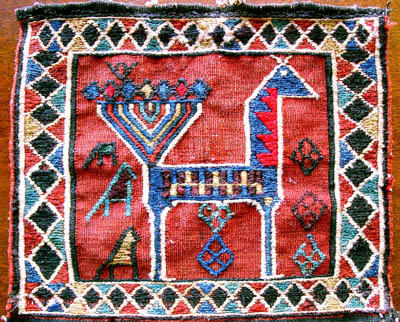
In this
case, the symbol is discrete from surrounding symbols and motifs, but in the
first weaving, it had arms/tails or something connecting it to other parts of
the design.
This chanteh has 4/2 irrregularly countered soumak , offset
soumak and diagonal wrapping. The diamond motifs are in diagonal wrapping.
It
is 11 1/2" wide and 9 1/2" tall. The top is folded over and sewn down and the
bottom has a row of weft twining and was wrapped under and has been cut off,
removing the back. The red in the neck of the peacock and in two of the diamonds
at the top of the tail are probably a synthetic dye, since the color is quite
bright compared to the rest of the colors. There are 8 distinct colors. I reckon
it was made in the early 20th century.
Perhaps these symbols provided an
aura of protection around the majestic bird, like "fairy dust" scattered around
it. They appear to be more apotropaic than tamga, even though the design is
similar to tamga designs. It is possible that the tamga symbol of a powerful
leader became ubiquitous as an apotropaic device through use by those wishing
the protection it provided.
Patrick Weiler
Posted by Kenneth Thompson on 04-18-2006 11:13 PM:
Dear Patrick,
From my experience in the region, the common apotropaic
signs commonly have eye-like or diamond-like. You can have diamonds within
diamonds which also can have that sense. There is no immediate source where on
can useful confirm that this symbol has this precise meaning, but the chances
are that diamonds or circles are anti-evil eye. Just as horseshoe may be a good
luck symbol, an Omega, or simply just a horsehoe. In the mind of the
beholder.
Triangles (muska) with the chains dangling down are also
protective amulet signs. A friend had a local mullah in Emirgan prepare one for
my wife. It was a protective charm in Arabic Script. It was folded (unread) into
a triangle, dipped in wax so that no one could break the spell and then put in a
silver muska triangle on a silver chain. It had an eye shape on it and also some
rendition of Allah. It worked wonders, of course.
Identification
symbols--I am not saying damgas since that gets us into specific terminology
about the original meaning of damga as an animal brand or official seal. But
clan or family IDs are not unusual. Yusuf Durul quotes a woman as saying that
the "IM (ie, damga) identifies our family line. [Soyumuz] and brings good
fortune [ugur] to us." He interviewed groups in Nigde, Bor, Taspinar, Incesu,
Maden etc. All are places with weaving traditions. So there is writing showing
that such symbols exist for that specific region. Whether one can extrapolate is
moot.
I will send along to Steve a scan of some of the IMs Durul found.
These might be of some interest in the discussion.
Best
regards,
Ken Thompson
Posted by Cevat Kanig on 04-19-2006 07:58 AM:
Hi folks,
Similar designs found in Anatolian Civilizations Museum on a
Hittite Sun Disk, it is possible that Symbol meaning is Anti-Evil eye.
Protection from evil, locking up the evil to a locker. Or to tied up the evil so
he can’t mess your mind.
Here is the Link of the Sun Disk http://rubens.anu.edu.au/raid4/turkey/ankara/museums/anatolian_civilizations/metalwork/hittite/alacahoyuk/DSCN0336.JPG
I
am on the way ACOR-8, I won’t have Internet
connection.
Regards.
Cevat Kanig
Posted by Steve Price on 04-19-2006 08:18 AM:
Hi people
Here is the scan to which Ken Thompson refers in his
post:

Thanks, Ken.
Steve Price
Posted by Chuck Wagner on 04-19-2006 06:27 PM:
Good Juju
Hi Pat,
Here are a couple images of a dwelling decoration from
northern Afghanistan or southern Uzbekistan; it's Uzbek material but who can
tell which side of the border it came from...
The triangular and diamond
motifs are everywhere, as well as mirrors to reflect the evil eye just in case
the triangles & diamonds miss something. All in all a very powerful piece,
designed to make a visitors and residents sleep comfortably with the
understanding that all things bad will bounce off the dwelling.
It's
interesting that the "triangles and diamonds" = "evil deflectors" notion extends
from Central Asia down into Africa; some old cultures with a few things possibly
in common ?
Here are the pics:

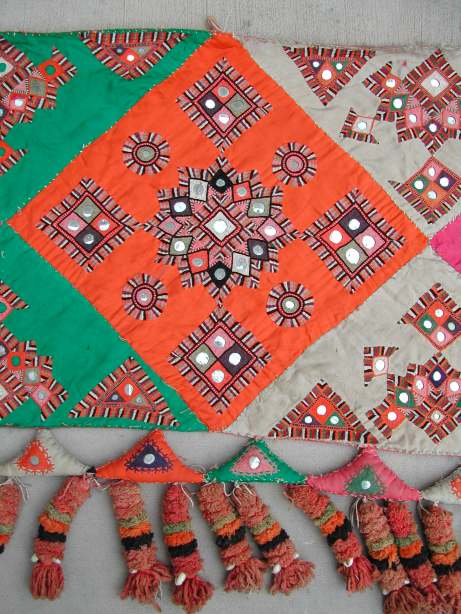
Regards,
Chuck
__________________
Chuck
Wagner
Posted by Walter_Davison on 04-19-2006 10:45 PM:
Hi Chuck,
This submission is far from rugs but close to deflectors of
evil -- your pictures of textiles with mirrors to ward off evil prompted me. In
Thailand, and in connection with the beliefs of those who tend toward "Feng
Shui" practices, a mirror strategically placed opposite an entrance door of a
dwelling will show the reflection of any evil spirit that happens to pass
through the entrance. The idea is that upon seeing its evil image in the mirror,
the spirit will be sufficiently frightened by its own evil face that it will
flee from the premises (your house). And as a matter of fact, I am not fearful
to admit, we have one such 6" by 8" framed mirror high on the wall facing our
entrance - you never can tell, you know.
Here's the mirror in its
hand-carved teak wood frame. The wood has even cracked, perhaps by an
encounter.
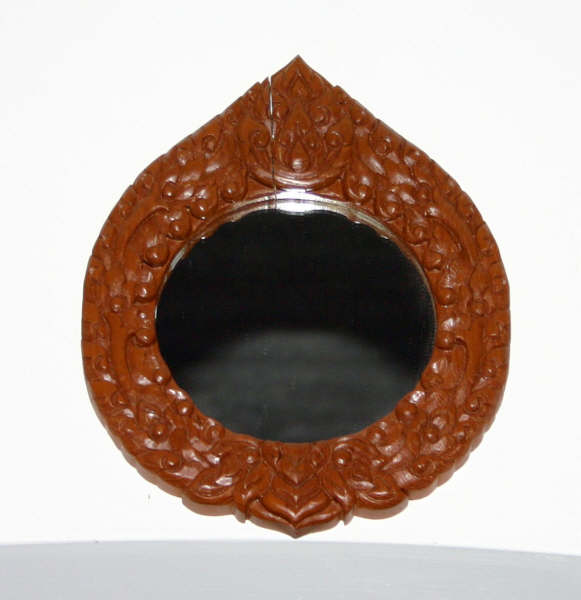
Walt
Posted by Patrick Weiler on 04-27-2006 05:32 PM:
More motifs
Here is a 19th century Shahsavan khorjin half, with back. You can readily see
the tamga motif in the center of the bag. I never paid any attention to the
motif until I was looking through my collection for tamga's:
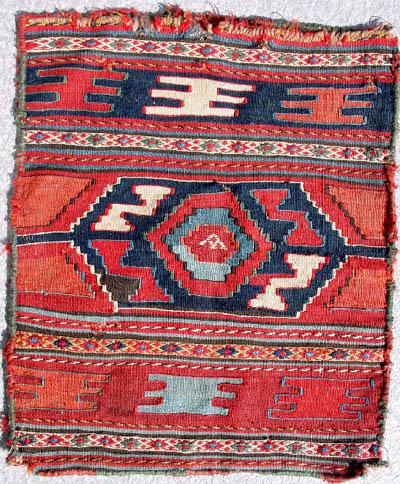
The next photo shows an early 20th
century small Bakhtiari salt bag with the ubiquitous amulet motif. I would not
call this motif a tamga, but more of an apotropaic device:
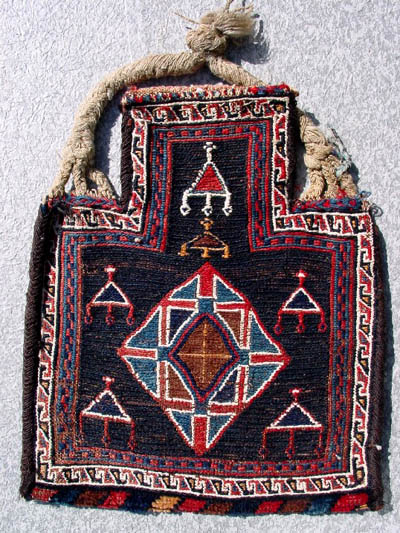
Now we come to a full Khamseh saddle
bag. The front includes numerous typical motifs of the SW Persian tribal weaving
tradition, including the horizontal "S", various quadrupeds including foxes,
"bird's head" devices, five-spot "domino" devices and Memling Guls:
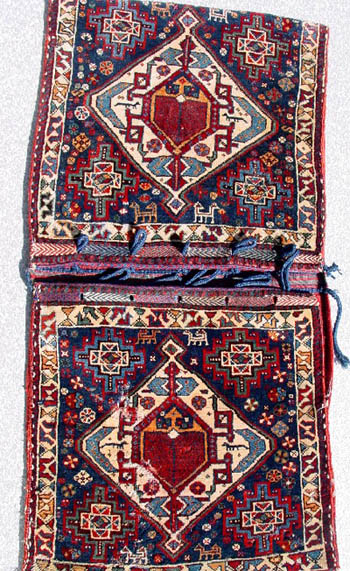
The backs are "plain", but a
close inspection of one of the backs reveals 5 knots placed apparently randomly
in the plain weave. This photo is shown with the back of the bag rotated 90
degrees. The dark knot shown halfway up, about a third of the way from the left
edge, is the "top" knot. A short distance to the right you can see a white knot
a bit above the dark knot and one more white knot below the dark blue knot. 2/3
of the way to the right another white knot is visible at nearly the same height
as the first blue knot and the final blue knot is seen in the dark-weft band at
the far right at about the same height as the upper white knot.
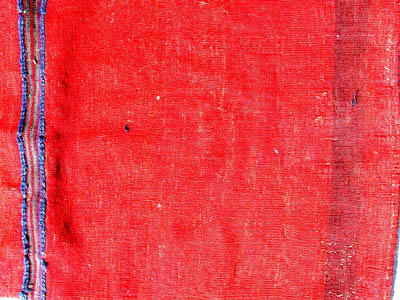
The "top" and "bottom" knots
(shown in the above photo as "left" and "right")are dark blue wool. The middle
three are white, but two of them are wool and the third is cotton! In this
photo, shown right-side up, the white knot on the left is wool and the white
knot on the right is cotton. Why are these knots put here, with different colors
and wool/cotton? Is the arrangement meaningful?:
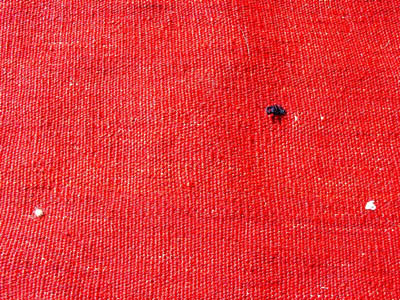
Here is a Baluch saddlebag that has
extra tufts of wool placed between some of the rows of designs. There are also
designs on the closure strips that may have importance above mere
decoration:
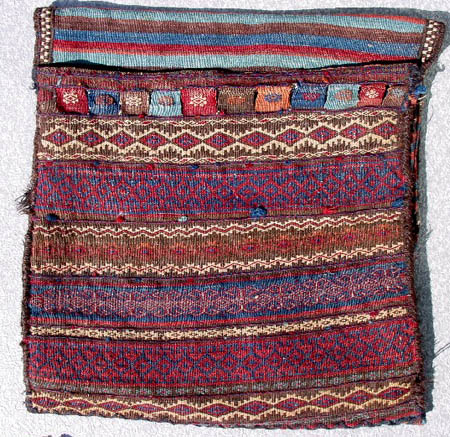
I have
read that sometimes this extra tufting was used in wedding weavings, but it,
too, may confer protection, fertility or good luck.
Patrick Weiler














 Interesting observation.
Interesting observation.
















 .
.











